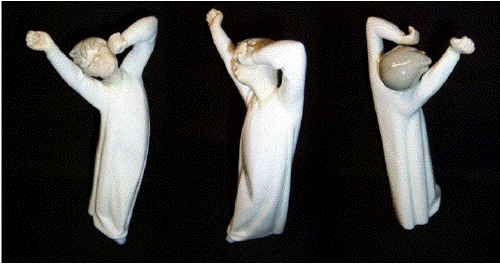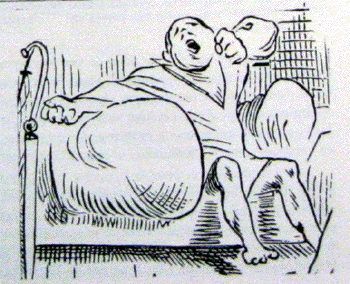La présence éventuelle d'une publicité ci-dessus est insérée par le routeur du mailing-liste indépendamment de mes choix en compensation de la gratuité de son service Dr O Walusinski baillement.com baillement.info yawning.info 

dimanche 1 janvier 2006 la lettre d'information du site baillement.com N°45 Si vous ne voyez pas les images, cliquez ici pour lire cette lettre dans votre navigateur. If you cannot see pictures below, to view the email in your web browser click here baillement.com est libre d'accès, base documentaire pour comprendre, chercher, travailler
-
Androgen-induced yawning in rhesus monkey females is reversed - with a nonsteroidal anti-androgen
- Franklynn C. Graves, Kim Wallen
- Hormones and Behavior
- 2006;49(2):233-236

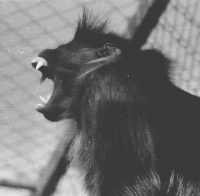
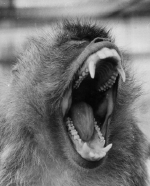
- Brain and sexual behavior
- K Larsson S Ahlenius
- Annals of the New York Academy of Sciences
- 1999; 877; 292-308
-
Androgenes influence on yawning behavior - In the adult rhesus monkey, yawning is an androgen-dependent sexually dimorphic behavior with males yawning more frequently than do females reflecting sex differences in circulating androgens. Studies in a variety of species indicate that yawning is mediated by various neurochemicals including dopamine, serotonin, and oxytocin. In rhesus monkeys, exogenous androgen reliably induces yawning in females to male-like levels. This study investigated whether flutamide, a nonsteroidal anti-androgen, reverses yawning induced by exogenous androgen administration in adult female rhesus monkeys. Six adult female rhesus monkeys were given chronic DHT alone and in combination with daily injections of flutamide and observed for yawning behavior. Treatment with DHT alone significantly increased yawning from 0.3 yawns per 30 min at the pretreatment baseline to 4.7 yawns per 30 min. Concurrent administration of flutamide significantly reduced the rate of yawning to 1.9 yawns per 30 min. These data indicate that flutamide is an effective tool for blocking the central effects of androgens in rhesus monkey females and that androgens regulate yawning similarly in both males and females. Androgenes modulate the activity of the oxytocin's neurons of the PVN of the hypothalamus.
- Les androgènes influencent le nombre des bâillements
- Chez le singe Macaque rhésus, le bâillement est sexuellement différencié car dépendant du taux d'androgènes circulants: les mâles bâillent plus que les femelles. La neurophysiologie du bâillement, étudiée chez de nombreuses espèces animales, implique l'intervention de nombreux neuromédiateurs: dopamine, sérotonine, et l'oxytocine etc. Chez le singe Macaque rhésus, l'administration d'androgènes à une femelle, afin d'obtenir un taux circulant comparable à celui d'un mâle, induit des bâillements en nombre comparable à celui du mâle. Ce travail a cherché à montrer l'effet d'un anti-testostérone non stéroïdien, le flutamide, chez une femelle Macaque rhésus, prélablement traitée par testostérone. Effectivement, le flutamide s'est montré capable de supprimer l'effet de la testostérone, et de faire disparaître les bâillements prélablement induits. Ceci montre un effet central du flutamide qui se révèle ainsi comme un moyen pharmacologique pouvant modifier des comportements hormonodépendants. La testostérone, tant chez le mâle que chez la femelle, semble agir en modulant l'activté des neurones oxytocinergiques du noyau paraventriculaire de l'hypothalamus.
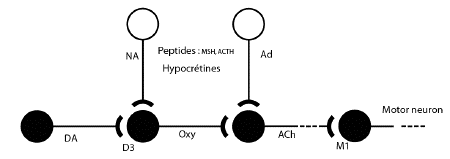
- Hormonal and genetic influences on arousal sexual and otherwise Pfaff D, Frohlich J.Trends Neurosci. 2002; .25; 1; 45-50
- Precision in mouse behavior genetics Pfaff D PNAS 2001; 98; 11; 5957-5960
- Sex hormone influences on yawning behavior Holmgren R, Holmgren U, Rodriguez R Acta Neurobiol Exp 1980; 40; 515-519
- Behavioral effects of an antiandrogen in adult male rhesus Macaques Deputte BL, Johnson J, Hempel M, Scheffler G Hormones and Behavior 1994; 28; 155-164
- Storage and display of odour by male Chiroptera Voigt CC, von Helversen O Behav Ecol Sociobiol 1999; 47; 29-40
- The influence of age, sex, rank on yawning behavior in two species of macaques Troisi A, Aureli F Ethology 1990; 86; 303-310
- Do men yawn more then women ? Schino G, Aureli F Ethol. sociobiol. 1989; 10; 375-378
- Androgen-induced yawning in rhesus monkey females is reversed with a nonsteroidal anti-androgen Graves FC, Wallen K Hormones and Behavior 2005, in press
- Threshold for behavioral response to testosterone in old castrated Male Rhesus Macaques Phoenix CH, Kathleen C Biology of reproduction1986; 35, 918-926
- Androgenic influences on apomorphine-induced yawning in rats Berendsen HG. Behavioral & Neural Biology 1981; 33; 123-128
- Testosterone potentiation of the effectiveness of ACTH on the induction of the strech-yawning syndrome in male Guinea Pigs Rodriguez-Sierra J Hormones and Behavior 1981; 15; 77-85
- Apomorphine facilitates male sexual behavior of Rhesus Monkeys Pomerantz SM. Pharmacol Biochem Behavior 1990; 35; 659-664
- Apomorphine and Oxytocin induced penile erection and yawning in intact and castrated male rats : effect of sexual steroids Melis MR, Argiolas A. Neuroendocrinology 1994;59; 349-354
- Genomic and non-genomic effects of steroïds on neuronal activity McEwen BS Trends Pharmacol Sci 1991; 12:141-147
- Sexual behavior in adult gonadectomized female pseudohermaphrodite, female, and male Rhesus Macaques treated with estradiol benzoate and testosterone propionate Phoenix CH, Chambers KC J Comp Physiol Psychol 1982, 96, 5; 823-833
- Gonadal hormones and behavior of normal and pseudohermaphroditic nonhuman female primates Goy, Resko Rec Progr Horm Res 1972; 28; 707-733
- Opiate-androgen interactions in drug-induced yawning and penile erections in the rats Berendsen HG, Gower AJ Neuroendocrinology 1986; 42; 185-190
- The conditioned response erection (CRE) a new approach to modelling erectile responses in the rat Brien SE, Wilson E, Heaton JP, Adams MA. Int J Impot Res. 2000;12; 2; 91-96.
- Effects of castration and exogenous testosterone supplementation in an animal model of penile erection Heaton JP, Varrin S J. J Urol 1994; 151; 3; 797-800
-
A case of familial inverse - Marcus Gunn phenomenon
- or Marin Amat syndrome
- Oh JY, Kim JE, Park KD, Choi Kg
- Department of Neurology, College of Medicine
- Ewha Womans University, Seoul, Korea
- J Neurol NeurorsugPsychiatry
- 2003; 74; 278
-
A case of familial inverse Marcus Gunn phenomenon - orMarin Amat syndrome
- Inverse Marcus Gunn phenomenon (or Marin Amat syndrom) is a rare congenital synkinetic movement presenting as eyelid drooping on jaw opening.
- Often this phenomenon follows peripheral facial palsy, suggesting abnormal synkinesis of the facial nerve.
- Oh JY et al. report a patient with familial inverse Marcus Gunn phenomenon and speculate on the neuronal mechanism with the support of electromyographic results.
- A 31 year old woman visited their clinic complaining of involuntary winking of her left eyelid on jaw opening. The symptom was most prominent when she opened her mouth forcefully, such as when eating or yawning. She stated that the symptom had been noticed from birth, and that her mother and uncle were also affected, but not her two sons. She had no history of previous peripheral facial palsy....
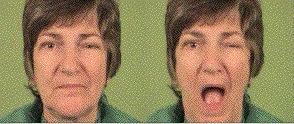
- video d'un syndrome de Marin Amat
- Un cas de syndrome de Marin Amat ou phénomène de Marcus Gunn inverse de forme familiale
- Le syndrome de Marin Amat est un mouvement anormal, souvent congénital, à type de syncinésie associant l'occlusion palpébrale lors de l'ouverture de la bouche, notamment au cours du bâillement. Il est l'inverse du phénomène de Marcus Gunn au cours duquel les personnes affectées d'un ptosis congénital constate la rétraction et l'élévation de la paupière lors de movements de diduction ou de protraction du maxillaire inférieur.
- Ce phénomène peut apparaitre après une paralysie faciale, suggérant une syncinésie des nerf facial - nerf trijumeau.
- Oh JY rapporte ici un cas de syndrome de Marin Amat et propose une explication à partir d'enregistrements EMG.
- Un femme agée de 31 ans consulte pour un clignement de paupière supérieure de l'oeil gauche, involontaire, survenant lors des ouvertures de bouche, surtout importantes, notamment lors des bâillements. Elle rapporte son origine congénitale et que sa mère et un oncle, mais aucun de ses deux fils sont pareillement affectés.. Elle n'avait aucun antécédent de paralysie faciale.
-
The Cognitive Neuroscience of Social Behaviour - Edited by: Alexander Easton, Nathan Emery
- Humans are social animals. Througthout the evolution of primates, our brains have evolved increasingly sophisticated neurocognitive mechanisms for understanding the emotions, predicting the actions and simulating the mental states of others. These brain mechanisms are now beginning to be understood through integration of the tools of cognitive neuroscience, animal behavior and social psychology.
- Standing at the vanguard of this development " The cognitive neuroscience of social behaviour " provides a seminal contribution to a subject still in infancy. Divided in three parts, the book presents a comprehensive overview of social cognitive neuroscience research in human and non-human animals, focusing on the neural basis of social interaction, the neurobiology of social cognition, and human disordres of social behavior and cognition, such as autims.
- Psychology Press
- 328 pages
- may 2005
- The Cognitive Neuroscience of Social Behaviour
- Edited by: Alexander Easton, Nathan Emery
- Les humains sont des êtres sociaux. Tout au long de l'évolution des primates, notre cerveau a peu à peu acquis des capacités de plus en plus nombreuses et élaborées. Cet enrichissement en mécanismes neurocognitifs a notamment permis de décoder une riche palette d'émotions, de prédire l'intentionalité et ainsi de simuler l'état mental des autres. Ces mécanismes sont de mieux en mieux compris en intégrant différents outils d'études relevant des neurosciences cognitives, de l'éthologie et de la psychosociologie.
- Se situant à l'avant garde des ces développements, " The cognitive neuroscience of social behaviour " procure une mise au point particulièrement pertinente de ces sujets en plein bourgeonnement. Divisé en trois parties, ce livre présente une mise à jour d'accès assez aisé des conniassances, chez l'homme et l'animal, de la neurobiologie des interactions sociales et cognitives, et aborde, en corélat, des domaines de psychopathologie comme l'autisme.
-
Yawn Like a Hippo!by Delia Noel, Ruth Galloway
-
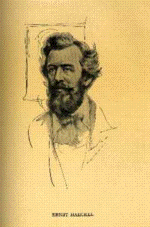
- Ernest Heinrich Haeckel
- 1834 - 1919
- L'histoire d'une découverte
- Michel Delarue
-
Ersnt Haeckel was an influential German evolutionist, morphologist, and developmental biologist. Following Müller, he argued that "ontogeny recapitulates phylogeny" and therefore that phylogeny should be reconstructed on the sole basis of ontogeny. The first important exponent of evolution in the German-speaking world, he also was the first in the world to create explicitly evolutionary phylogenies of all animals. He was broadly Darwinian, but had Lamarckian and vitalist tendencies. His speculative and somewhat spiritualistic approach brought him into a decades-long conflict with the influential, anti-evolutionary Prussian anthropologist and pathologist Virchow. Haeckel's attempt to describe human evolution in racial terms later became a part of the pseudo-scientific basis for Nazism. Haeckel coined the term "ecology" (1866) 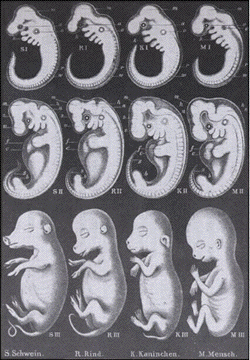
- L'embryon d'une espèce donnée ne ressemble jamais à la forme adulte d'une espèce apparue précédemment dans l'évolution mais plutôt à sa forme embryonnaire. Un embryon de reptile ou de mammifère ne passe jamais par un stade poisson. En revanche, les embryons de reptiles et de mammifères possèdent des caractères en commun avec les embryons de poisson. Par exemple, les arcs viscéraux des reptiles et des mammifères ne ressemblent pas aux arcs branchiaux des poissons mais plutôt aux arcs viscéraux embryonnaires de ces derniers. Cette notion est particulièrement importante pour comprendre la diversité au cours de l'évolution quand on sait que les arcs viscéraux des mammifères sont transformés en structures auditives et laryngées... ontogenèse du bâillement.
-
Wilhelm Busch (1832-1908) - "Die Fromme Helen"
- 1872
- chap III Vetter Franz fig 4
-
A case of pachymeningitis haemorrhagica interna - Guy H. Fisk
- Montreal
- The Canadian MedicalAssociation Journal
- oct 1933; 412-415
-
History of the present illness: About June 15, 1932, he began to have very frequent headaches across his forehead. They were often present on waking up in the morning and would last nearly all day. Aspirin gave him temporary relief. The headaches continued and on June 30, 1932, while returning home by train a numbness developed in his right arm and leg. On reaching home he felt very tired and next morning he still had the same numb feeling in his right extremities. Although able to walk he could not hold anything in his right hand, which hung loosely at his side. This condition lasted until July 10th, when he fell unconscious. The loss of consciousness was only temporary and he was immediately put to bed. Since that time, although he is stated to have recovered consciousness, he had said nothing but "yes" and "no." Associated with this aphasia there had been frequent yawning, snapping of the fingers and incontinence of the urine and faeces. On July 12th the paralyzed arm, which had been cold, became warm and tender and the yawning became less frequent On July 13th he was admitted to the hospital..... - Une histoire d'accident vasculaire datant de 1932...
-
Hysteria at the Edinburgh Infirmary - Hysteria
- A lecture by James Gregory
- delivered in 1788-1789
-
The same tendency to imitate isobserved in many other instances -as yawning, laughing, etc. As the muscles however employed in these last actions are in general subservient to the will, we can prevent the operation of that remarkable tendency towards them and l am sure much may be effected in that in hysteria. It is a maxim I inculcate very strongly to my patients, to use their utmost endeavours to prevent the coming on of fits. I have often known it succeed though my advice is by many not well received. - In others their predisposition is so strong that their endeavours are ineffectual. In some there is a peculiar pleasure that attends the coming on of the fit analogous I suppose to that we experience in yawning, and that they really encourage them and bring them on by reason of every possible effort, and in cases like these I should suppose every remedy must prove inefficacious. Fits are frequently brought on by theatrical performances. This happened in several instances during Mrs. Siddon's performing at Edinburgh. I knew one instance in Paris where death was the consequence of a violent fit occasioned by the representation of a tradgedy.
-
Autres documents mis en ligne ce mois-ci :
- 7-OH-DPAT, unlike quinpirole, does not prime a yawning response in rats Oswiecimska J
- Antagonism of drug-induced yawning and penile erections in rats Gower AJ
- Apomorphine produced more yawning in Sprague-Dawley rats than in F344 rats: a pharmacological study Tang AH
- Paradoxical sleep deprivation in female rats alters drug-induced behaviors Hipolide DC, Tufik S
- The NK-3 tachykinin agonist senktide elicits yawning and chewing mouth movements following subcutaneous administration in the rat. Evidence for cholinergic mediation Stoessl AJ, Dourish CT, Iversen SD
- Effects of streptozotocin-induced diabetes on dopaminergic functioning in the rat: analysis of yawning behavior Heaton JP, Varrin SJ
- Metoclopramide decreases apomorphine-induced yawning and penile erection Heaton JPW, Varrin SV
- Yawning: the inside story Walusinski O
Résultats du sondageau 31 décembre 2005 Recherche par mot du site
-
Nombre de questionnaires remplis : 1876 - Combien de fois bâillez-vous par jour ? <5 = 24,7%.. 5-10 = 26,2%.. 10-15 = 15.3%.. 15-20 = 9,2%.. >20 = 24,6%
- Ressentez-vous des baillements excessifs ?
- 66,7% = non, tant mieux
- 28,% = oui et je ne sais pas pouquoi
- 7,8% = oui et je prends des antidépresseurs
- 1,0% = oui et je prends des anti-épileptiques
- 4,6% = oui et je prends d'autres médicaments
- 2,7% = oui et j 'ai des troubles neurologiques
- 2,3% = oui et j 'ai des troubles hormonaux
- 2,7% = oui et j 'ai des tics moteurs
- 1,8% = oui et j 'ai des tocs
- déclenchez-vous facilement le bâillement d'autrui ? 74,7%
- êtes-vous sensible au bâillement d'autrui ? 73%
E. Sober, Philosophy of Biology, Boulder, Westview Press, 1993.
- Sober : « Les sociétés ont les propriétés qu'elles ont uniquement à cause des propriétés psychologiques des individus qui la composent, les propriétés psychologiques individuelles dépendent uniquement de certaines propriétés biologiques, ces propriétés biologiques dépendent à leur tour uniquement des processus biochimiques qui se déroulent à l'intérieur des individus, et ces processus chimiques eux-mêmes dépendent uniquement de processus physiques ».
baillement.com baillement.info yawning.info écrits et réalisés par le Dr Walusinski
Voici le nombre d'abonnés à cette lettre : courriel à adresser lire les lettres précédentes d'information du site


